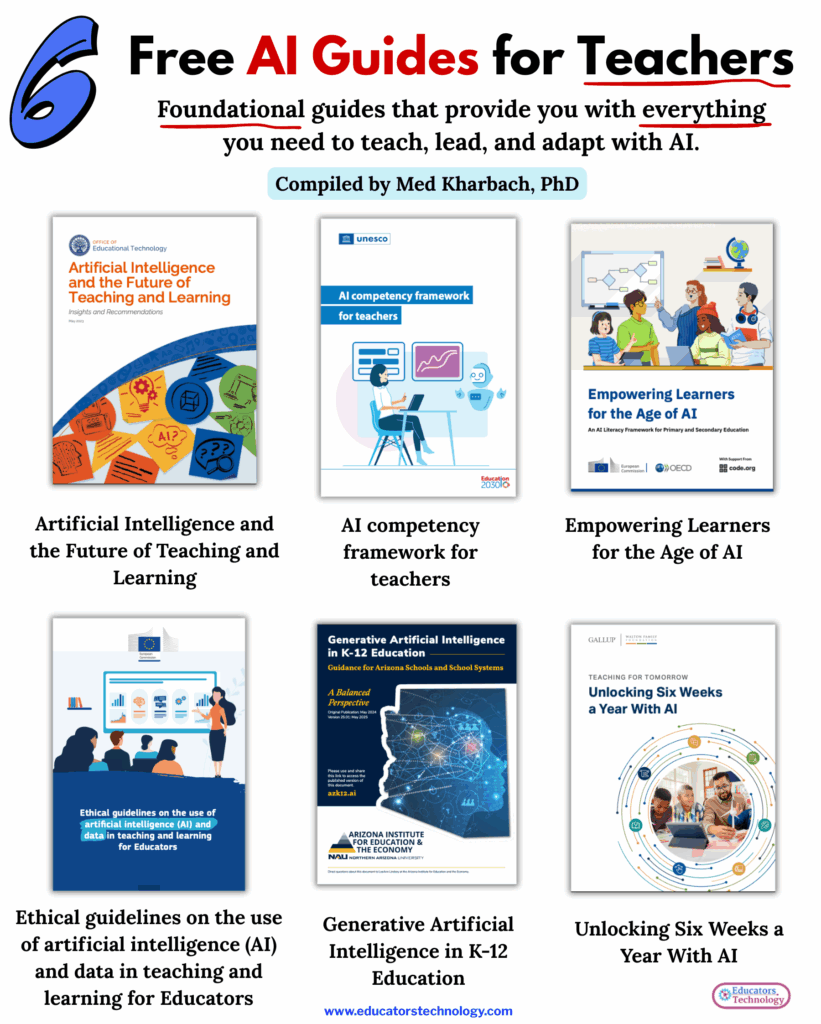One thing I always emphasize in my workshops and talks: focus on building your AI literacy and ignore the tired fear-mongering about AI taking your job or making students cheat. That narrative is stale.
If you’ve been paying attention, you already know where education is heading. In the U.S., the federal government now expects school districts to integrate AI into teaching. Canada and several other countries are following suit. AI is becoming table stakes, not a side trend.
This isn’t about chasing hype. It’s about adapting to real change and growing with it.
Foundational AI Guides for Teachers
Here are six essential guides from trusted sources. Bookmark them. Read them. They’ll help you build the AI literacy you need to stay relevant, informed, and ahead of the curve.
Guide 1: Artificial Intelligence and the Future of Teaching and Learning by the U.S. Department of Education (2023)
This guide helps teachers understand the big picture of AI in education both its opportunities and risks. It lays out practical recommendations for keeping humans (especially educators) at the center, ensuring equity, and using AI tools safely and transparently.
Teachers will come away with a clearer view of how to evaluate AI tools, protect student data, and integrate AI in ways that actually support learning without giving up their professional judgment or agency. It’s not just about using AI; it’s about using it wisely.
Guide 2: AI Competency Framework for Teachers by UNESCO (2024)
This guide gives teachers a roadmap for building the knowledge and skills they need to use AI effectively and ethically in the classroom. It breaks down AI competence into clear areas like understanding how AI works, using it to support learning, and teaching students about its risks and benefits.
Teachers will find this guide especially useful for planning their own professional development and helping students become AI-literate citizens. It’s practical, global, and focused on real classroom impact.
Guide 3: Empowering Learners for the Age of AI: An AI Literacy Framework for Primary and Secondary Education by the AI for Education initiative (2024)
This guide focuses on helping teachers build students’ AI literacy from the ground up. It outlines what students should know about AI, how it works, how it affects their lives, and how to use it responsibly. The framework includes clear learning outcomes and ideas for classroom activities across grade levels. T
eachers will find this guide helpful for weaving AI into everyday subjects, not as a separate topic but as part of digital citizenship and critical thinking. It’s a solid starting point for bringing AI into K–12 education with confidence.
Guide 4: Ethical Guidelines on the Use of Artificial Intelligence and Data in Teaching and Learning by the European Commission (2022)
This guide helps teachers make ethical decisions when using AI and student data in education. It lays out core values like fairness, transparency, and human oversight and offers practical examples of how to apply these in real classroom situations.
Teachers will find clear questions to ask before using AI tools, tips for protecting student privacy, and guidance on staying aligned with democratic values. It’s a must-read for anyone who wants to use AI in ways that are not just effective, but also responsible.
Guide 5: Generative Artificial Intelligence in K–12 Education: Guidance for Arizona Schools and School Systems by the Arizona Department of Education (2024)
This guide offers clear, classroom-friendly policies for using generative AI in K–12 schools. It helps teachers know what’s allowed, what’s not, and where to be cautious. It introduces the Red–Yellow–Green light system for AI use, and reinforces the principle that human educators must always have the final say.
Teachers will find practical examples, policy templates, and key questions to guide decision-making. It’s hands-on, grounded, and built to support safe and meaningful AI use in real classrooms.
Guide 6: Teachers and AI: A View from the Classroom by the Walton Family Foundation and Gallup (2024)
This guide gives teachers a real snapshot of how their peers across the U.S. are thinking about and using AI in the classroom. It shares survey insights, concerns, and success stories from educators, offering a grounded, honest look at what’s working and what’s not.
Teachers will find themselves reflected in the data and can use these findings to shape their own approach to AI, whether they’re just starting out or looking to deepen their use. It’s practical, relatable, and packed with real voices.
Related: AI Resources for Teachers and Educators









